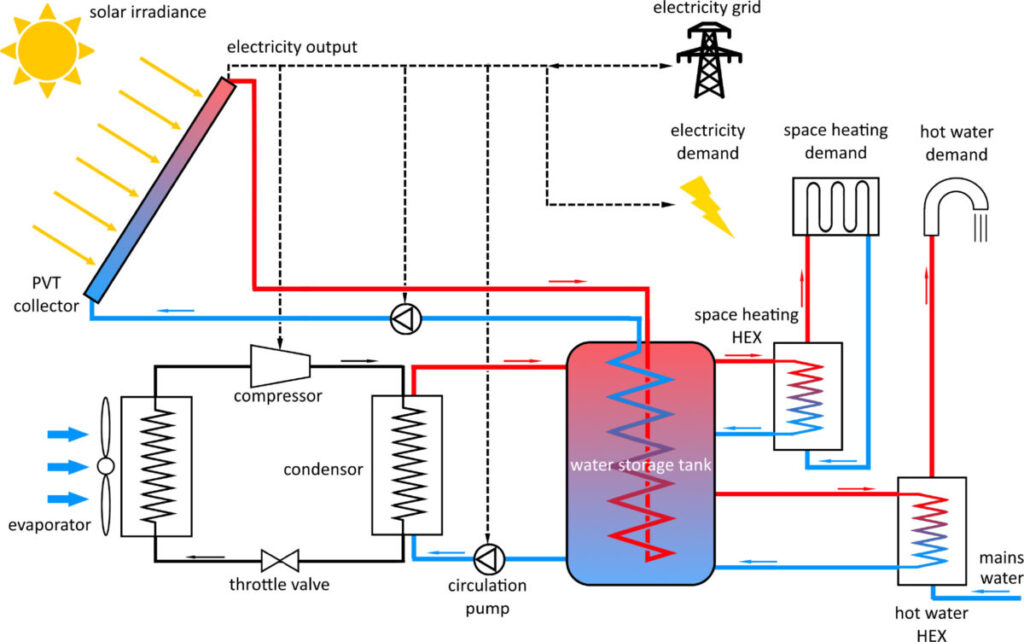Researchers in Germany have modeled dozens of indirect exhibition solar-assisted heat pump systems using photovoltaic thermal panels for single-family homes in Munich in Munich, Berlin and Hamburg. Simulations were responsible for local weather, electricity use and thermal demand.
An international research group led by the Karlsruhe Institute of Technology of Germany has carried out energy, economic and environmental reviews of 54 photovoltaic thermal (PVT) Indirect-Expansie (IDX) solar-assisted heat pumps (SAHPs) and found only two configuration that has been positive.
The group used MatLab to simulate systems with three coolants – R32, Propaan and R410A.
The researchers analyzed a parallel IDX SAHP setup in which the storage tank is heated by two separate loops: an immersed coil of the PVT collector and an external heat exchanger (HEX) of the Heatpomplus. The tank offers both the demand for hot water (HWD) and the space heating demand (SHD) via two extra hexs.
All systems used 1.55 m² PVT panels with a rating of 260 W, with 16% electrical efficiency and 51% optical thermal efficiency. The 54 tested configurations include the three coolants, three design temperatures (-9.2 C, -8.3 C, -6.1 C), three spinning temperature differences (3 C, 5 C, 10 C) and two heat (5,500 W and 7,000 W).
From this the team selected three representative systems per coolant: one well -performing, higher cheap system with the top average performance -coefficient (COP); a cheaper, cheaper-performance system with the lowest total costs; And a medium option that offers an average agent and moderate price.
Image: Karlsruhe Institute of Technology, Energy, CC by 4.0
All systems were simulated for a single -family home in Munich, Berlin or Hamburg, with the help of location -specific weather, electricity demand and thermal demand data. Each house had a floor area of 93.1 m², with 89.1 m² heated floors. The roof measured 82.4 m², with 32.9 m² covered with PVT panels to support the SAHP.
“From an energy perspective, for the household considered, the system allowed more than a third of the annual heat demand and about half of the annual electricity demand of the device is covered by solar energy. However, a mismatch between solar energy generation and heat consumption limits the capacity of the system to” the Academic Solar Geregie. “During the summer, the demand for low heat was largely satisfied by solar energy. In the winter, the greater heat demand in the winter was mainly covered by the HP that was carried out on Grid’s electricity.”
The analysis showed that the SAHP system reached the highest coverage of solar energy in Munich and met up to 39% of the heat demand for the tested cities. In all configurations, the powerful design supplied the highest solar contribution with the help of R32 cooling agent.
“Economically and Environmentally, Designs Showing Higher Demand Coverage by Solar Energy had the best performance. The high-performance HP designs using R32 and Propane Were the only Ones Shown to Be a Viable Investment with Positive Net Present) or Pavy, and and $ 960 ($, and $, and and and € 960, and and € 960, and and € 960, and and € 960, and € 256, and € 960, and € 960, and € 256, and € 960) or € 960) or € 960) or € 966 ($ 555) or € 9pv) of € 9pv) of € 9pv) or € 9ack. (PBT) Lower than the Technology Lifetime (19.3 and 19.8 years), “The Scientists Said. “By comparing the SAHP with other technologies, a self -standing HP or natural gas boiler could only match the Livalized costs of energy (LCOE) of the SAHP at exceptionally low electricity or gas prices.”
Their findings appeared in “Extensive energy, economic and environmental analysis of a hybrid photovoltaic thermal (PVT) heat pump system“Published in Energy. Researchers from the German Karlsruhe Institute of Technology, the University of Cyprus and the University of Science and Technology of Egypt also participated in the study.
This content is protected by copyright and may not be reused. If you want to work with us and reuse part of our content, please contact: editors@pv-magazine.com.
Popular content


